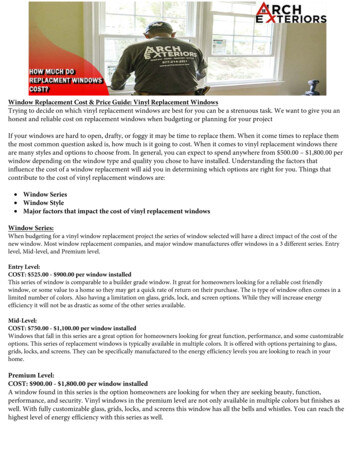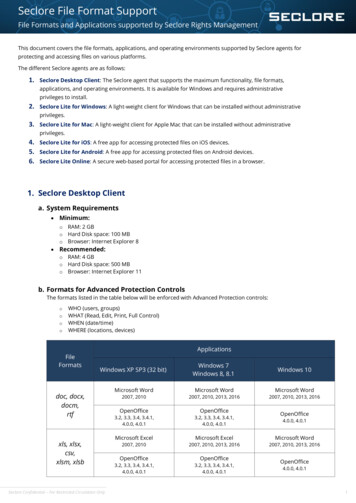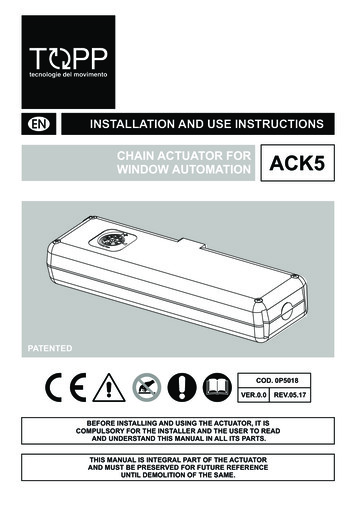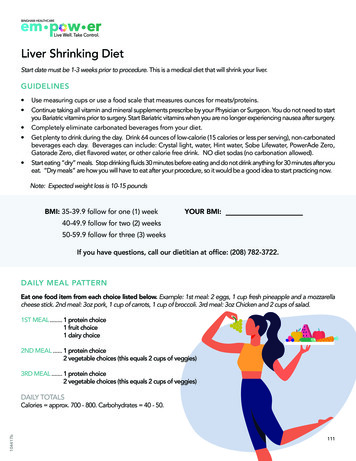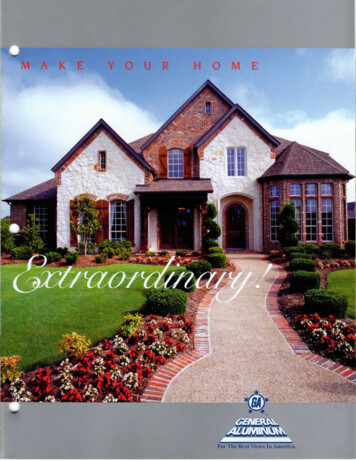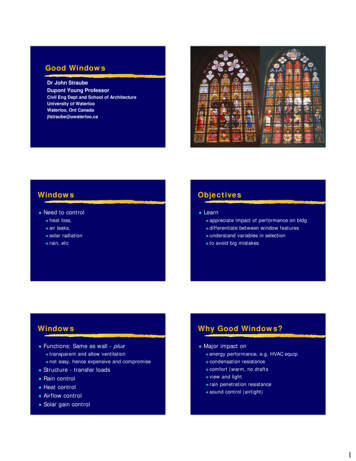
Transcription
Good WindowsBrussels WindowDr John StraubeDupont Young ProfessorCivil Eng Dept and School of ArchitectureUniversity of WaterlooWaterloo, Ont Canadajfstraube@uwaterloo.caWindowszNeed to controlObjectiveszheat loss,Î air leaks,Î solar radiationÎ rain, etcWindowszFunctions: Same as wall - plustransparent and allow ventilationÎ not easy, hence expensive and compromiseÎzzzzzStructure - transfer loadsRain controlHeat controlAirflow controlSolar gain controlLearnappreciate impact of performance on bldgdifferentiate between window featuresÎ understand variables in selectionÎ to avoid big mistakesÎÎÎWhy Good Windows?zMajor impact onenergy performance, e.g. HVAC equipÎ condensation resistanceÎ comfort (warm, no draftsÎ view and lightÎ rain penetration resistanceÎ sound control (airtight)Î1
Controlling Heat FlowzzHeat Fow: ImportantWindows usually have the lowest thermalperformance of all parts of the enclosureMust control heat forComfortÎ EnergyÎ HealthÎ Durability18 ft5.5m m2 storey house49 ft 15 m33 ft 10 mÎConduction Losses onlyWindow area 18% floor area2950 sf wall area of which:80% (2360) opaque @ R2020% (590) window @ R21600 sf roof area @R40Prevent CondensationAir Leakage at 0.35 ACH28%63%9%100 164Window Performance MetricsComfortz 132 295 40 467Warmer windows more comfort!zHeat flow (R,U)zSolar Heat Gain Coefficient (SHGC)zVisual Transmittance (VT)zAir leakagezCondensation resistancezWater penetrationTotal Heat FlowParts of a Window1. Frames2. Glazing (IGU)3. Gaskets and hardwareCoatingCoatingCoatingPrimary SealantSpacerSeal (tape)Seal (gasket)glazingsystemU-valueSecondary SealantFrame2
Anatomy of an IGUzzzIGU Insulated Glazing Unit Coating Glazing Spacer Seal FillMust be sealed to control condensationDesiccant absorbs moisture for 25 yearsGas FillszzzFillConductivity(W/mK)Reduction inConductive non0.005179%Double IGULow-E, Gas Fills, Gap SizezGas fills reduce the amount of heattransferred by conduction and convectionthrough the space in the glazing unitNo impact on solar gainDouble and Triple Glazing can have verygood R-values and control solar gainMajor factors for glazingRadiation control coatings (low E)Gas fillsÎ Size of GapÎÎTriple IGUWarm-edge / super spacerszzzHeat flow through spacers is importantCritical for condensation controlSuper spacesPlastic/foam edges sealsstainless steel, very thinÎ Dramatically reduce coolglazing edgesÎÎ3
CondensationzzRequires cold surface ANDhigh indoor relative humiditySolutionsenergy efficient glazingreduced thermal bridging (frame/spacers)Î reduce RH via ventilation/source controlÎÎzPrioritiescontrol interior RH (cheap repair or retrofit)Thermal break (alu) or insulated framesÎ Warm edge spacers, then Low-E argonÎÎFrame MaterialsFrameszDifferent modes of operationÎzA wide selectionfixed, awning, casementDifferent materialsaluminumwoodÎ vinylÎ fibreglassÎ wood-plastic compositesÎÎ4
WoodzzzzzzInsulates wellPretty Strong and StiffAestheticRotsRequires maintenanceCombustible?Wood Clad w/Alu or VinylzzzzzzInsulates wellPretty Strong and StiffRequires little maintenanceInterior AestheticStill RotsCombustible ?Aluminum /MetalzzzzzzzzzStrong and StiffDurableExcellent insulationzzzzzzExpensive (?)InexpensiveInsulates well (design influences this)Low maintenanceCan have added insulationExpands, contracts, warpsCorners leakFlexible - may need stiffenersCompositeszWood and plastic resinStrong and stiffInsulates like woodLess maintenanceNo rotzNewzzzzzVery Conductive (1600 times wood)Must have a thermal breakbigger break is betterVinylzFibreglassDurableStiffStrong5
Frames Heat LossFunctionsR1.5Performance MetricsR2R3Kawneer Isoport 518Solar Heat GainCoefficientzzSHGC Solar Heat Gain Coefficient Fraction of solar radiation that passesTypical clear, dbl-glazed window SGHC 0.72Î Typical Double glazing 0.72 – 0.76Î Reflective or dark time 0.10 - 0.30Î Spectrally Selective clear 0.30 - 0.40Higher SHGC?Îz 150 sq.ft. south-facing glassChange from 0.57 to 0.27 SHGCAir conditioning load reduction 1 ton!Avoid air conditioning?Maybe small residential buildings in heating climateLow SHGC? ( 0.5)ÎÎÎCommercial buildingsBuildings with large glazing ratios (large window/wall area)Buildings in cooling or mixed climateSolar Gains - July 21 @45 NSolar Gains - Jan 21 @ 45 N900900North WallSolar Gain (W/m2)North Wall800East Wall700South WallWest Wall600Roof500Solar Gain (W/m2)zHow much difference does SHGC make?800East Wall700South WallWest Wall600Roof500Mother Nature is try to tell you something400300400300200200100100000612Hour of the Day182406121824Hour of the Day6
SHGC, Whole windowVisible Transmittance0.600.50VT is fraction of visible light that istransmittedClear Double glazing VT 0.75-0.80VT over 0.60 tend to look untinted andhelps daylightingTinting changes colorLow-E coatings do notz0.400.30z0.20z0.10z0.00Low-e, high Low-e, low Low-e triple,solar gainsolar gainlow solargainzVisible TransmittanceWindows - ResidentialTypical Residential Window U-ValuesSHGC VT0.62 -lvind/ssyl-loubl-dwooylvind/wooergla0.49f ib0.39air5.56-low-e0.18dTriple Low E Fiberglass0.00f ib0.530.50woo0.520.30n2.783.13ow-e0.360.32-lDbl Low-E Gain Wood/vinylDbl Low-E Shade Wood/vinyl0.10ad0.58cl0.56argo2.04d0.490.20wooDbl Clr Wood/vinyl0.30ssR1.560.40glaU0.640.50eIncluding FrameDouble-glaze broken AluU-value, Btu/sq.ft.-hr-F0.60adzzrzclzaizzow-ezReduced SHGC with a high VTAllows daylighting and view with low solarheat gainTend to have good U-valueszVT Visible Transmittance Fraction of visible light that passesTypical clear, dbl-glazed window VT 0.75-0.80Windows with VT 0.50 are perceived to be clearTinting changes the color of light that passeslow-e coating does not change colorSpectrally selective: lower SHGC with good VTow-ezSpectrally Selective-lDoubleglassylSolar Heat Gain Coefficient (SHGC)0.707
Window ThermalFlankingFunction: Air LeakagezzzzzNFRC AL rates how much leakage basedon standard conditionsDoes not include frame to wall!Aim for less than 0.20 cfm/ft2Weather stripping & DurabilityCompression fittings are tighterÎzJoints aroundwindow need to beairsealedStuffing with battdoes not workzWindows are not designed to take loadsfrom the buildingÎzDesign joints to accommodate movementWindow must support wind loads andtransmit these to the secondary structureOutsideOutsideInsideInsideThermal FlankingFlanking ReducedNFRC LabelzRead the labelU-value (1/R)( 0.35)SHGC (heating/cooling?, west? South?)Î VT ( 0.50, 0.60)Î AL (NFRC optional)(low!)ÎÎzSupportBeware heat flow around window frame7 C at cornerhence casement, awning windows better thanslidersWindow Air Leakagezzwww.NFRC.orgRain ControlzzzzWindows are weak spots in enclosuresThey attract waterThey often leak internallyThey often leak around windowLarger glazing areas & higher wind loads (e.g.high rise buildings) require thicker glassÎ Beware large flexible PVCÎ Frame transfers load from glazing unit to wallÎ8
www.efficientwindows.orgResidentialSmall BuildingsOnlyConclusionszzzUnderstand importance of windows tobuilding performanceBalance U, SHGC, and VTDesign and builddraining sills, drained windowsÎ air barrier continuity with windowÎzWebsiteszUniversity of WaterlooBuilding Engineering GroupÎzwww.civil.uwaterloo.ca/begBalanced SolutionsÎwww.balancedsolutions.comCurtainwalls - use less glass of betterquality with better shade9
R1.5 Kawneer Isoport 518 Solar Heat Gain Coefficient zSHGC Solar Heat Gain Coefficient Fraction of solar radiation that passes zTypical clear, dbl-glazed window SGHC 0.72 ÎTypical Double glazing 0.72 - 0.76 ÎReflective or dark time 0.10 - 0.30 ÎSpectrally Selective clear 0.30 - 0.40 zHigher SHGC?

